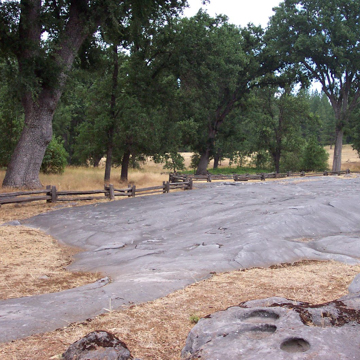You are here
Indian Grinding Rock State Historic Park
Established as a state park in 1962, Indian Grinding Rock falls within the rough contours of Eastern Miwok lands, in the Sierra Nevada foothills, on a site local Miwoks called Nomlaki. There are other Miwok kinship groups historically associated with more western areas of California, the Coastal Miwoks north of San Francisco and the Lake Miwoks northwest of Davis. Today’s Northern Sierra Miwok, a subgroup of Eastern Miwoks, claim the marbleized limestone grinding rock as specific to their heritage. This foothill tribe was distinct enough from other Miwoks down in the plains and near the bay that anthropologists consider their speech to have diverged into a separate language. Archaeological evidence suggests that these groups moved into foothill and mountain regions relatively recently.
The Miwok people proved that the contribution of Native American to California’s architectural legacy extends beyond the backbreaking labor of coastal groups who built Franciscan missions. The grinding rock or chaw’se, for which the park is named, is one example of the Miwok built environment. The holes native women workers bore into rock, what archaeologists identify as “bedrock mortars,” are a sign of the time and energy they put into smashing acorns, which they used to make a mush that sustained their communities for generations. These holes were part of an early stage in the acorn preparation process and remind us that Miwoks made the earth itself into an indispensable tool in their labor. Rather than manufacturing above-ground granaries, sieves, or ovens, Miwok workers engineered small caves into acorn storage units, shallow sand basins into sieves for leaching tannins out of the mush, and heated rocks and earth ovens into their cooking utensils. Otherwise, they only needed to manufacture baskets for transporting acorns, mush, and other edibles.
At sites like the grinding rock, Miwoks would sometimes construct a series of grinding houses over the bedrock mortars in times of inclement weather. These structures were conventionally made of bark slabs, but some records indicate Miwoks later built them out of wooden boards. Foothill and mountain groups slept in conical structures called u’macha’, also made of bark slabs. Earth ovens in these spaces served both cooking and heating needs. Flooring was made of pine needles. For bedding, deerskins sufficed for most and bearskins marked the privileged status of important men. Miwoks appeared to structure gender roles into their built environment. Small ceremonial huts temporarily housed menstruating girls. Slightly larger sweathouses were for men preparing to hunt.
Larger structures called hun-ge were the setting for community rituals like mourning. These lodges each contained a sunken pit, 40 to 50 feet in diameter, and appeared from outside to be a thick roof supported by poles and made out of brush and earth. While users entered and exited through small openings on the sides, a rooftop hole released smoke into the sky. This state park was a likely location for such events, for bringing so many members of the far-flung community to one place to mourn for up to four days required a large stock of food supplies. Women laborers would arrive to grind acorns as many as three days ahead of time. They needed an abundance of mortars if they were to work at the same time. What sets this site apart is not only the number of mortars, but also the pictographs surrounding these mortars. Today, visitors can witness the marks of both work and culture in the rock at their feet.
The State of California has commissioned reproductions of some of the Miwok structures to assist visitors in imagining what everyday life was like at this site. The Chaw-se Regional Indian Museum is part of the newer built environment. There, artifacts not only from the Miwok but a number of other nearby tribal groups are on display. The building’s design resembles a Miwok roundhouse, but local Miwoks gather each September and use a different structure constructed by the tribe as the site for Big Time, a celebration of the acorn harvest.
References
“Indian Grinding Rock SHP.” California Department of Parks and Recreation. Accessed February 27, 2016. http://www.parks.ca.gov.
Levy, Richard. “Eastern Miwok.” In Handbook of North American Indians. Vol. 8. Edited by William C. Sturtevant. Washington, DC: Smithsonian Institution, 1978.
Madley, Benjamin. An American Genocide: The United States and the California Indian Catastrophe, 1846–1873. New Haven: Yale University Press, 2016.
Merriam, C. Har. “The Mourning Ceremony of the Miwok, 1906.” In The California Indians: A Source Book. Edited by R.F. Heizer and M.A. Whipple. Berkeley: University of California Press, 1971.
Nabokov, Peter, and Robert Easton. Native American Architecture. New York: Oxford University Press, 1989.
Writing Credits
If SAH Archipedia has been useful to you, please consider supporting it.
SAH Archipedia tells the story of the United States through its buildings, landscapes, and cities. This freely available resource empowers the public with authoritative knowledge that deepens their understanding and appreciation of the built environment. But the Society of Architectural Historians, which created SAH Archipedia with University of Virginia Press, needs your support to maintain the high-caliber research, writing, photography, cartography, editing, design, and programming that make SAH Archipedia a trusted online resource available to all who value the history of place, heritage tourism, and learning.





